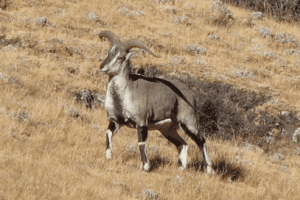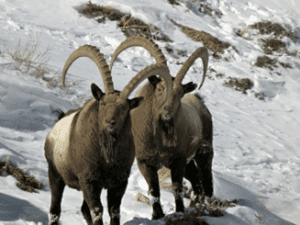TAG: GS 3: ECOLOGY AND ENVIRONMENT
THE CONTEXT: Wildlife authorities in Himachal Pradesh’s high-altitude, cold desert district of Lahaul & Spiti have embarked on a significant census exercise to estimate the population of blue sheep (bharal) and Himalayan ibex.
EXPLANATION:
- These species are vital prey for the iconic snow leopard, an apex predator in the region.
- Recent conservation efforts have led to a rebound in their numbers, prompting this detailed survey.
Survey:
- Methodology and Duration
- The survey, conducted by field staff from the National Conservation Foundation and the Wildlife Division, Spiti, will span 15 days.
- The team will navigate the challenging terrain of the district, which borders Chinese-controlled Tibet, utilizing the double observer survey technique.
- This method ensures accuracy and reliability in counting the animal populations.
- Initial Findings
- On the first day of the survey, a total of 453 blue sheep were spotted in the Tabo area, according to Deputy Conservator of Forest (Wildlife) Spiti, Mandar Jeware.
- This initial count indicates a healthy presence of blue sheep in the region.
Conservation Measures
- There is a strict ban on hunting all wild animals, including blue sheep and Himalayan ibex, in Lahaul & Spiti.
- The local population, predominantly Buddhists, abstains from hunting activities in line with their religious beliefs, contributing significantly to wildlife conservation.
- No cases of poaching have been reported, reflecting the community’s commitment to preserving wildlife.
- The increase in blue sheep and Himalayan ibex numbers can be attributed to the combined efforts of the forest department and the local community.
- These animals are now frequently seen in his village. This increase has also led to more frequent sightings of snow leopards.
Impact on Snow Leopards
- Snow leopards, classified as ‘vulnerable’ under the International Union for Conservation of Nature’s (IUCN) Red List of endangered species, depend on blue sheep and Himalayan ibex as their primary prey.
- The rebound in prey populations is crucial for the survival and health of snow leopards in the region.
- Locals have pledged not to hunt wildlife, further supporting the snow leopard population.
- Injured wild animals are handed over to the forest department for treatment, ensuring their recovery and continued contribution to the ecosystem.
Economic and Tourism Benefits
- The rise in sightings of snow leopards, blue sheep, and Himalayan ibex has boosted wildlife tourism in Lahaul & Spiti.
- Tourists flock to the cold desert to witness these majestic creatures, creating economic opportunities for local residents.
- Many locals are now engaged in tourism-related activities, catering to thousands of visitors each year.
- This economic incentive encourages the community to protect and conserve wildlife, aligning financial benefits with conservation goals.
Snow leopard:
- It is found in the mountainous regions of central and southern Asia.
- In India, it is seen in Jammu and Kashmir, Himachal Pradesh, Uttarakhand and Sikkim and Arunachal Pradesh.
- The Hemis National Park has a good presence of Snow Leopard.
- They play a key role as a top predator, an indicator of the health of their high-altitude habitat, and, increasingly, an important indicator of the impacts of climate change on mountain environments.
- Solo traveller:the snow leopard is usually solitary and highly elusive
- Crepuscular:dawn and dusk are the cat’s most active times
- Living large:some snow leopards have home ranges of up to 1,000 square kilometers
- Single moms:for about 18 months, females raise their cubs – all alone
- Cold and dry:the snow leopard primarily lives in arid, barren mountain areas
- Gentle:snow leopards are not known to be aggressive toward humans
- Carnivorous:the cat’s main prey are ibex, argali and blue sheep
- Conservation status:
- IUCN Red List: Vulnerable
- Under CITES it is listed in Appendix I
- Wildlife (Protection) Act 1972: Schedule I

Blue sheep:
- The Bharal (Pseudois nayaur), also known as the blue sheep, is native to the high Himalayas and is the only member of the Pseudois species.
- It is found in India, Bhutan, China (in Gansu, Ningxia, Sichuan, Tibet, and Inner Mongolia), Myanmar, Nepal, and Pakistan.
- Blue Sheep is placed in Schedule III protected animals under the Indian Wildlife Protection Act 1972.
- This schedule also includes chital (spotted deer), bharal (blue sheep), hyena and sambar (deer).
- The dwarf blue sheep is classified as Endangered on the 2003 IUCN Red List of Threatened Species and is protected under the laws of Sichuan Province.

Himalayan ibex:
- Himalayan ibex (Capra ibex sibirica) range is spread across the mountains of Pakistan, China, India, Afghanistan, Kyrgyzstan, Kazakhstan, Uzbekistan, Mongolia, Russia and Tajikistan.
- This species is listed as the least concerned as per the IUCN status.
- The Himalayan Ibex is found mostly in the trans-Himalayan hills of the Union Territories of Ladakh, Jammu, Kashmir, and Himachal Pradesh. It is also found in Jammu and Kashmir’s Greater Himalayas and Pir Panjals range.
- The Bara Lacha La Pass to the north and the Satluj Gorge to the south of the Great Himalayan Range in Himachal Pradesh appear to mark the eastern boundary where Himalayan Ibex are found India.
- The southernmost range of Himalayan Ibex is Manali Wildlife Sanctuary in Himachal Pradesh, south of the Pir Panjal Range.
- In the Hindukush–Karakoram–Himalayan (HKH) region it inhabits the relatively dry mountains between 2000 m and 5000 m elevations.





